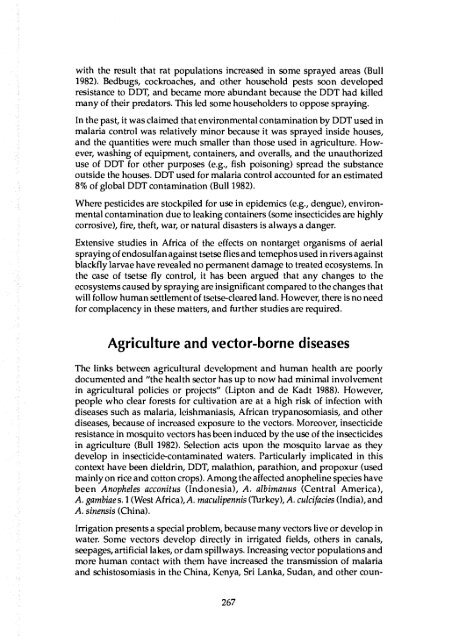Impact of - IDL-BNC @ IDRC - International Development Research ...
Impact of - IDL-BNC @ IDRC - International Development Research ...
Impact of - IDL-BNC @ IDRC - International Development Research ...
Create successful ePaper yourself
Turn your PDF publications into a flip-book with our unique Google optimized e-Paper software.
with the result that rat populations increased in some sprayed areas (Bull<br />
1982). Bedbugs, cockroaches, and other household pests soon developed<br />
resistance to DDT, and became more abundant because the DOT had killed<br />
many <strong>of</strong> their predators. This led some householders to oppose spraying.<br />
In the past, it was claimed that environmental contamination by DDT used in<br />
malaria control was relatively minor because it was sprayed inside houses,<br />
and the quantities were much smaller than those used in agriculture. However,<br />
washing <strong>of</strong> equipment, containers, and overalls, and the unauthorized<br />
use <strong>of</strong> DDT for other purposes (e.g., fish poisoning) spread the substance<br />
outside the houses. DDT used for malaria control accounted for an estimated<br />
8% <strong>of</strong> global DDT contamination (Bull 1982).<br />
Where pesticides are stockpiled for use in epidemics (e.g., dengue), environmental<br />
contamination due to leaking containers (some insecticides are highly<br />
corrosive), fire, theft, war, or natural disasters is always a danger.<br />
Extensive studies in Africa <strong>of</strong> the effects on nontarget organisms <strong>of</strong> aerial<br />
spraying <strong>of</strong> endosulfan against tsetse flies and temephos used in rivers against<br />
blackfly larvae have revealed no permanent damage to treated ecosystems. In<br />
the case <strong>of</strong> tsetse fly control, it has been argued that any changes to the<br />
ecosystems caused by spraying are insignificant compared to the changes that<br />
will follow human settlement <strong>of</strong> tsetse-cleared land. However, there is no need<br />
for complacency in these matters, and further studies are required.<br />
Agriculture and vector-borne diseases<br />
The links between agricultural development and human health are poorly<br />
documented and "the health sector has up to now had minimal involvement<br />
in agricultural policies or projects" (Lipton and de Kadt 1988). However,<br />
people who clear forests for cultivation are at a high risk <strong>of</strong> infection with<br />
diseases such as malaria, leishmaniasis, African trypanosomiasis, and other<br />
diseases, because <strong>of</strong> increased exposure to the vectors. Moreover, insecticide<br />
resistance in mosquito vectors has been induced by the use <strong>of</strong> the insecticides<br />
in agriculture (Bull 1982). Selection acts upon the mosquito larvae as they<br />
develop in insecticide-contaminated waters. Particularly implicated in this<br />
context have been dieldrin, DDT, malathion, parathion, and propoxur (used<br />
mainly on rice and cotton crops). Among the affected anopheline species have<br />
been Anopheles acconitus (Indonesia), A. albimanus (Central America),<br />
A. gambiae s.1 (West Africa), A. maculipennis (Turkey), A. culcifacies (India), and<br />
A. sinensis (China).<br />
Irrigation presents a special problem, because many vectors live or develop in<br />
water. Some vectors develop directly in irrigated fields, others in canals,<br />
seepages, artificial lakes, or dam spiliways. Increasing vector populations and<br />
more human contact with them have increased the transmission <strong>of</strong> malaria<br />
and schistosomiasis in the China, Kenya, Sri Lanka, Sudan, and other coun-<br />
267

















